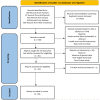Genetic and epigenetic effects on couple adjustment in context of romantic relationship: A scoping systematic review
- PMID: 36816018
- PMCID: PMC9937082
- DOI: 10.3389/fgene.2023.1002048
Genetic and epigenetic effects on couple adjustment in context of romantic relationship: A scoping systematic review
Abstract
Introduction: Couples' relationships defined by a complex interaction between the two partners and their intrapersonal traits. Romantic; relationships and love are associated with marital satisfaction and stability, as well as couples' happiness and health. Personality traits influence romantic relationships and, personality influenced by genetical and non-genetically factors. The roles of non-genetically factors such as socioeconomic position and external appearance have revealed in determining the quality of romantic relationships. Methods: We; performed a scoping systematic review to assess the association between genetics and epigenetic factors and romantic relationship. Relevant articles were identified by PubMed, EMBASE, Web of Science, Scopus, and the APA PsycInfo searching between inception and 4 June 2022. Results: Different studies evaluated the associated polymorphisms in 15 different genes or chromosomal regions. In the first step; we classified them into four groups: (1) Oxytocin-related signaling pathway (OXTR, CD38, and AVPR1A); (2) Serotonin-related signaling pathway (SLC6A4, HTR1A, and HTR2A); (3) Dopamine and catecholamine-related signaling pathway (DRD1, DRD2, DRD4, ANKK1, and COMT); and (4) other genes (HLA, GABRA2, OPRM1, and Y-DNA haplogroup D-M55). Then, we evaluated and extracted significant polymorphisms that affect couple adjustment and romantic relationships. Discussion: Overall, the findings suggest that genetic and epigenetics variants play a key role in marital adjustment and romantic relationships over time.
Keywords: couple adjustment; epigenetics; genetics; marital adjustment; romantic relationship.
Copyright © 2023 Khani, Ansari Dezfouli, Nasri, Rahemi, Ahmadloo, Afkhami, Saeidi, Tereshchenko, Bigdeli and Modarressi.
Conflict of interest statement
The authors declare that the research was conducted in the absence of any commercial or financial relationships that could be construed as a potential conflict of interest.
Figures



Similar articles
-
After the Honeymoon: Neural and Genetic Correlates of Romantic Love in Newlywed Marriages.Front Psychol. 2020 May 7;11:634. doi: 10.3389/fpsyg.2020.00634. eCollection 2020. Front Psychol. 2020. PMID: 32457675 Free PMC article.
-
CD38 is associated with communal behavior, partner perceptions, affect and relationship adjustment in romantic relationships.Sci Rep. 2020 Aug 20;10(1):12926. doi: 10.1038/s41598-020-69520-y. Sci Rep. 2020. PMID: 32820186 Free PMC article.
-
Affective Behavior in Parent Couples Undergoing Couple Therapy: Contrasting Case Studies.Front Psychol. 2021 Mar 18;12:634276. doi: 10.3389/fpsyg.2021.634276. eCollection 2021. Front Psychol. 2021. PMID: 33815220 Free PMC article.
-
The effectiveness of couple-based interventions on the marital outcomes of women with genital and breast cancer and their partners: a systematic review and meta-analysis.BMC Cancer. 2024 Mar 27;24(1):391. doi: 10.1186/s12885-024-12088-x. BMC Cancer. 2024. PMID: 38539118 Free PMC article.
-
Love in the time of COVID-19: A systematic mapping review of empirical research on romantic relationships one year into the COVID-19 pandemic.Fam Process. 2022 Sep;61(3):1208-1228. doi: 10.1111/famp.12775. Epub 2022 Apr 13. Fam Process. 2022. PMID: 35419816 Free PMC article.
Cited by
-
Associations of the AVPR1A RS1 Microsatellite Locus with the Level of Hormones of the Anterior Pituitary Gland and Personality Traits.Biochem Genet. 2024 Sep 28. doi: 10.1007/s10528-024-10933-z. Online ahead of print. Biochem Genet. 2024. PMID: 39340576
References
-
- Acevedo B. P., Aron A. (2009). Does a long-term relationship kill romantic love? Rev. General Psychol. 13 (1), 59–65. 10.1037/a0014226 - DOI
Publication types
LinkOut - more resources
Full Text Sources
Research Materials
Miscellaneous

